Research on Nonlinear Absorption Effect in KDP and 70%-DKDP Crystals
Abstract
:1. Introduction
2. Experimental
3. Results
3.1. Nonlinear Absorption Characteristics of KDP and 70%-DKDP Crystals at λ = 1064 nm
3.2. Nonlinear Absorption Characteristics of KDP Crystal at λ = 532 nm
3.3. Nonlinear Absorption Characteristics of 70%-DKDP Crystal at λ = 532 nm
3.4. Discussion
4. Conclusions
Acknowledgments
Author Contributions
Conflicts of Interest
References
- Liu, B.; Yin, X.; Sun, X.; Xu, M.; Ji, S.; Xu, X.; Zhang, J. Growth and electro-elastic properties of K(H1−xDx)2PO4 single crystals. J. Appl. Cryst. 2012, 45, 439–443. [Google Scholar] [CrossRef]
- Li, T.L.; Zhao, X.H.; Zheng, Y.L.; Chen, X.F. Conical second harmonic generation in KDP crystal assisted by optical elastic scattering. Opt. Express 2015, 23, 23827–23833. [Google Scholar] [CrossRef] [PubMed]
- Sharma, S.K.; Verma, S.; Singh, Y.; Bartwal, K.S. Growth technique to increase the device purpose yield of a KDP crystal and assessment of its quality using X-ray and optical techniques. CrystEngComm 2013, 15, 9955–9962. [Google Scholar] [CrossRef]
- Liu, F.F.; Yu, G.W.; Zhang, L.S.; Li, L.; Wang, B.; Gan, X.Y.; Ren, H.K.; Zhou, H.L.; Zhu, L.L.; Ji, S.H.; et al. Effect of super-saturation on hillock of directional Growth of KDP crystals. Sci. Rep. 2014, 4, 1–5. [Google Scholar]
- Cui, Z.J.; Liu, D.; Sun, M.Z.; Miao, J.; Zhu, J.Q. Compensation method for temperature-induced phase mismatch during frequency conversion in high-power laser systems. J. Opt. Soc. Am. B 2016, 33, 525–534. [Google Scholar] [CrossRef]
- Ji, S.H.; Wang, F.; Zhu, L.L.; Xu, X.G.; Wang, Z.P.; Sun, X. Non-critical phase-matching fourth harmonic generation of a 1053-nm laser in an ADP crystal. Sci. Rep. 2013, 3, 1605. [Google Scholar] [CrossRef] [PubMed]
- Guo, D.C.; Jiang, X.D.; Huang, J.; Wang, F.R.; Liu, H.J.; Xiang, X.; Yang, G.X.; Zheng, W.G.; Zu, X.T. Effects of γ-ray irradiation on optical absorption and laser damage performance of KDP crystals containing arsenic impurities. Opt. Express 2014, 22, 29020–29030. [Google Scholar] [CrossRef] [PubMed]
- De Mange, P.; Negres, R.A.; Rubenchik, A.M.; Radousky, H.B.; Feit, M.D.; Demos, S.G. Understanding and predicting the damage performance of KDxH2−xPO4 crystals under simultaneous exposure to 532- and 355-nm pulses. Appl. Phys. Lett. 2006, 89, 1–3. [Google Scholar]
- Hu, G.H.; Zhao, Y.N.; Li, D.W.; Xiao, Q.L. Transmittance increase after laser conditioning reveals absorption properties variation in DKDP crystals. Opt. Express 2012, 20, 25169–25180. [Google Scholar] [CrossRef] [PubMed]
- Schaffer, C.B.; Brodeur, A.; Mazur, E. Laser-induced breakdown and damage in bulk transparent materials induced by tightly focused femtosecond laser pulses. Meas. Sci. Technol. 2001, 12, 1784–1794. [Google Scholar] [CrossRef]
- Li, F.Q.; Zong, N.; Zhang, F.F.; Yang, J.; Yang, F.; Peng, Q.J.; Cui, D.F.; Zhang, J.Y.; Wang, X.Y.; Chen, C.T.; et al. Investigation of third-order optical nonlinearity in KBe2BO3F2 crystal by Z-scan. Appl. Phys. B 2012, 108, 301–305. [Google Scholar] [CrossRef]
- Sheik-Bahae, M.; Said, A.A.; Wei, T.H.; Hagan, D.J.; Van Stryland, E.W. Sensitive measurement of optical nonlinearities using a single beam. IEEE J. Quantum. Electron. 1990, 26, 760–769. [Google Scholar] [CrossRef]
- Wang, D.L.; Li, T.B.; Wang, S.L.; Wang, J.Y.; Wang, Z.P.; Ding, J.X.; Li, W.D.; Shen, C.Y.; Liu, G.X.; Huang, P.P. Effect of Fe3+ on third-order optical nonlinearity of KDP single crystals. CrystEngComm 2016, 18, 9292–9298. [Google Scholar] [CrossRef]
- Messias, D.N.; Pilla, V.; Andrade, A.A.; Catunda, T. Nd:YAG optical electronic nonlinearity and energy transfer up conversion studied by the Z-scan technique. Opt. Mater. Express 2015, 5, 2588–2596. [Google Scholar] [CrossRef]
- Ganeev, R.A.; Kulagin, I.A.; Ryasnyansky, A.I.; Tugushev, R.I.; Usmanov, T. Characterization of nonlinear optical parameters of KDP, LiNbO3 and BBO crystals. Opt. Commun. 2004, 229, 403–412. [Google Scholar] [CrossRef]
- Shaikh, R.N.; Anis, M.; Shirsat, M.D.; Hussaini, S.S. Investigation on the linear and nonlinear optical properties of L-lysine doped ammonium dihydrogen phosphate crystal for NLO applications. J. Appl. Phys. 2014, 6, 42–46. [Google Scholar]
- Silambarasan, A.; Rao, E.N.; Rao, S.V.; Rajesh, P.; Ramasamy, P. Bulk growth, crystalline perfection and optical characteristics of inversely soluble lithium sulfate monohydrate single crystals grown by the conventional solvent evaporation and modified Sankaranarayanan–Ramasamy method. CrystEngComm 2016, 18, 2072–2080. [Google Scholar] [CrossRef]
- Jin, L.T.; Wang, X.Q.; Ren, Q.; Cai, N.N.; Chen, J.W.; Li, T.B.; Liu, X.T.; Wang, L.N.; Zhang, G.H.; Zhu, L.Y.; et al. Preparation, characterization and third order nonlinear optical properties of the bis (tetrabutylammonium)–[Cd (dmit)2] (dmit = 2-thioxo-1, 3-dithiol-4, 5-dithiolate) for all-optical switching applications at blue–green light band. J. Cryst. Growth 2012, 356, 10–16. [Google Scholar] [CrossRef]
- Fan, H.L.; Wang, X.Q.; Ren, Q.; Li, T.B.; Zhao, X.; Sun, J.; Zhang, G.H.; Xu, D.; Sun, Z.H.; Yu, G. Third-order nonlinear optical properties in [(C4H9)4N]2[Cu(C3S5)2]-doped PMMA thin film using Z-scan technique in picosecond pulse. Appl. Phys. A 2009, 99, 279–284. [Google Scholar] [CrossRef]
- Wang, D.L.; Li, T.B.; Wang, S.L.; Wang, J.Y.; Wang, Z.P.; Xu, X.G.; Zhang, F. Study on nonlinear refractive properties of KDP and DKDP crystals. RSC Adv. 2016, 6, 14490–14495. [Google Scholar] [CrossRef]
- Wang, D.L.; Li, T.B.; Wang, S.L.; Wang, J.Y.; Shen, C.Y.; Ding, J.X.; Li, W.D.; Huang, P.P.; Lu, C.W. Characteristics of nonlinear optical absorption and refraction for KDP and DKDP Crystals. Opt. Mater. Express 2017, 7, 533–541. [Google Scholar] [CrossRef]
- Bhar, G.C.; Chaudhary, A.K.; Kumbhakar, P. Study of laser induced damage threshold and effect of inclusions in some nonlinear crystals. Appl. Surf. Sci. 2000, 161, 155–162. [Google Scholar] [CrossRef]
- Cook, W.R., Jr. Thermal Expansion of Crystals with KH2PO4 Structure. J. Appl. Phys. 1966, 38, 1637–1642. [Google Scholar] [CrossRef]
- Nelmes, R.J. Structural studies of KDP and the KDP-type transition by neutron and X-ray diffraction: 1970–1985. Ferroelectrics 1986, 71, 87–123. [Google Scholar] [CrossRef]
- Liu, W.J.; Wang, S.L.; Gu, Q.T.; Ding, J.X.; Liu, G.X.; Sun, Y.; Liu, L.; Wang, B. Growth, structural and optical properties of 12%-deuterated KDP crystals. Cryst. Res. Technol. 2013, 48, 314–320. [Google Scholar] [CrossRef]
- Pritula, I.; Gayvoronsky, V.; Gromov, Y.; Kopylovsky, M.; Kolybaeva, M.; Puzikov, V.; Kosinova, A.; Savvin, Y.; Velikhov, Y.; Levchenko, A. Linear and nonlinear optical properties of dye-doped KDP crystals: Effect of thermal treatment. Opt. Commun. 2009, 282, 1141–1147. [Google Scholar] [CrossRef]
- Gurzadyan, G.G.; Ispiryan, R.K. Two-photon absorption peculiarities of potassium di-hydrogen phosphate crystal at 216 nm. Appl. Phys. Lett. 1991, 59, 630–631. [Google Scholar] [CrossRef]
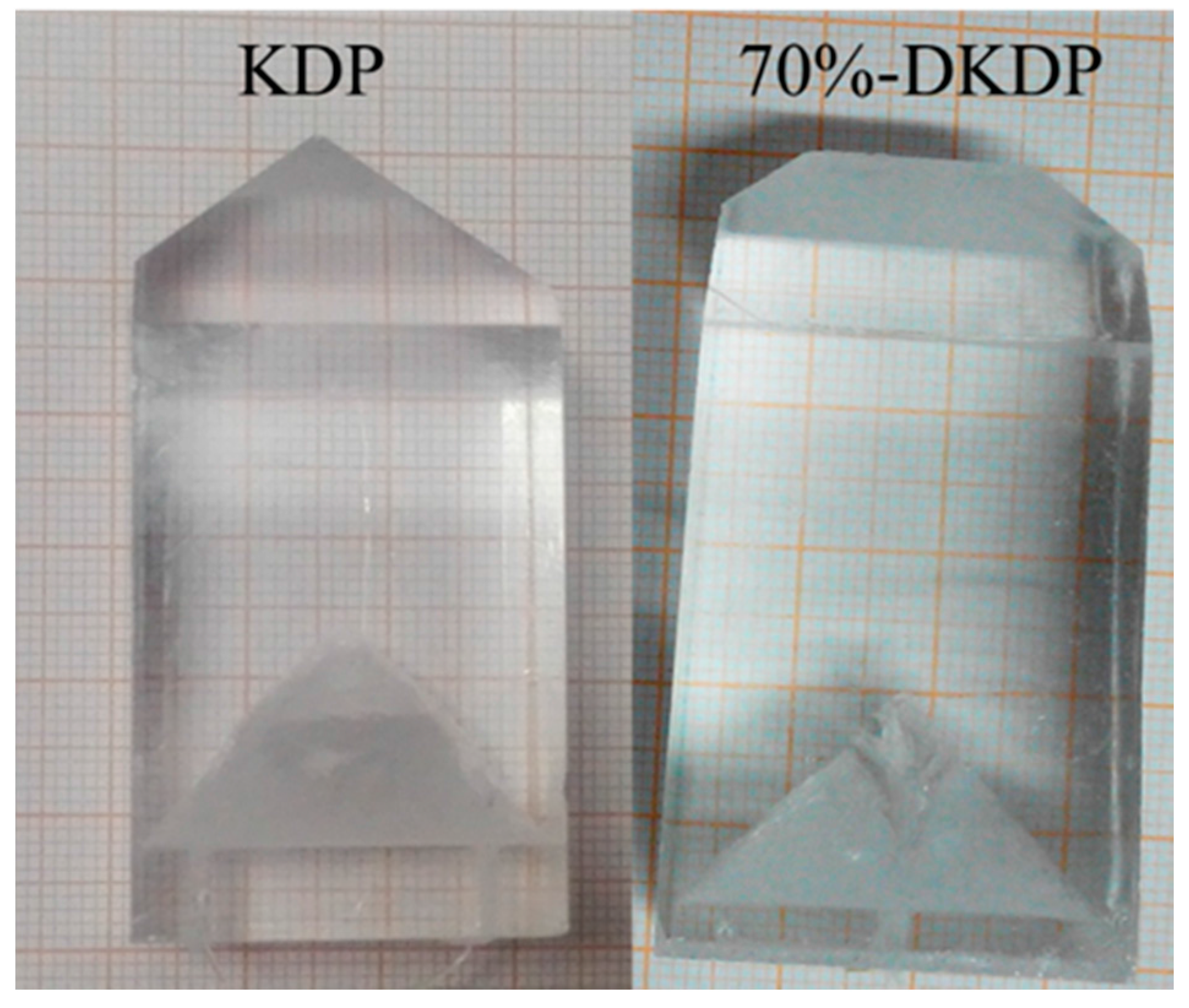
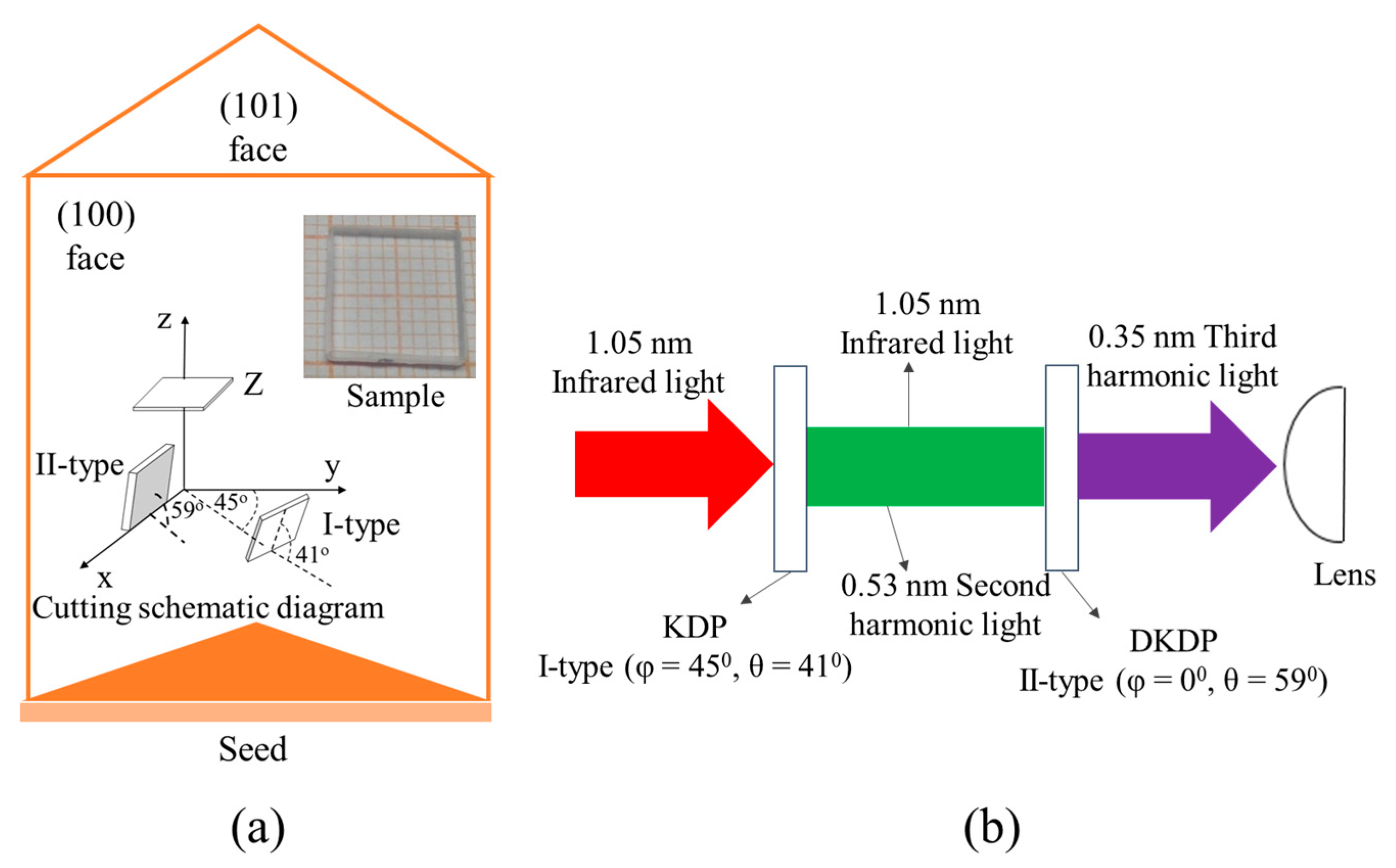
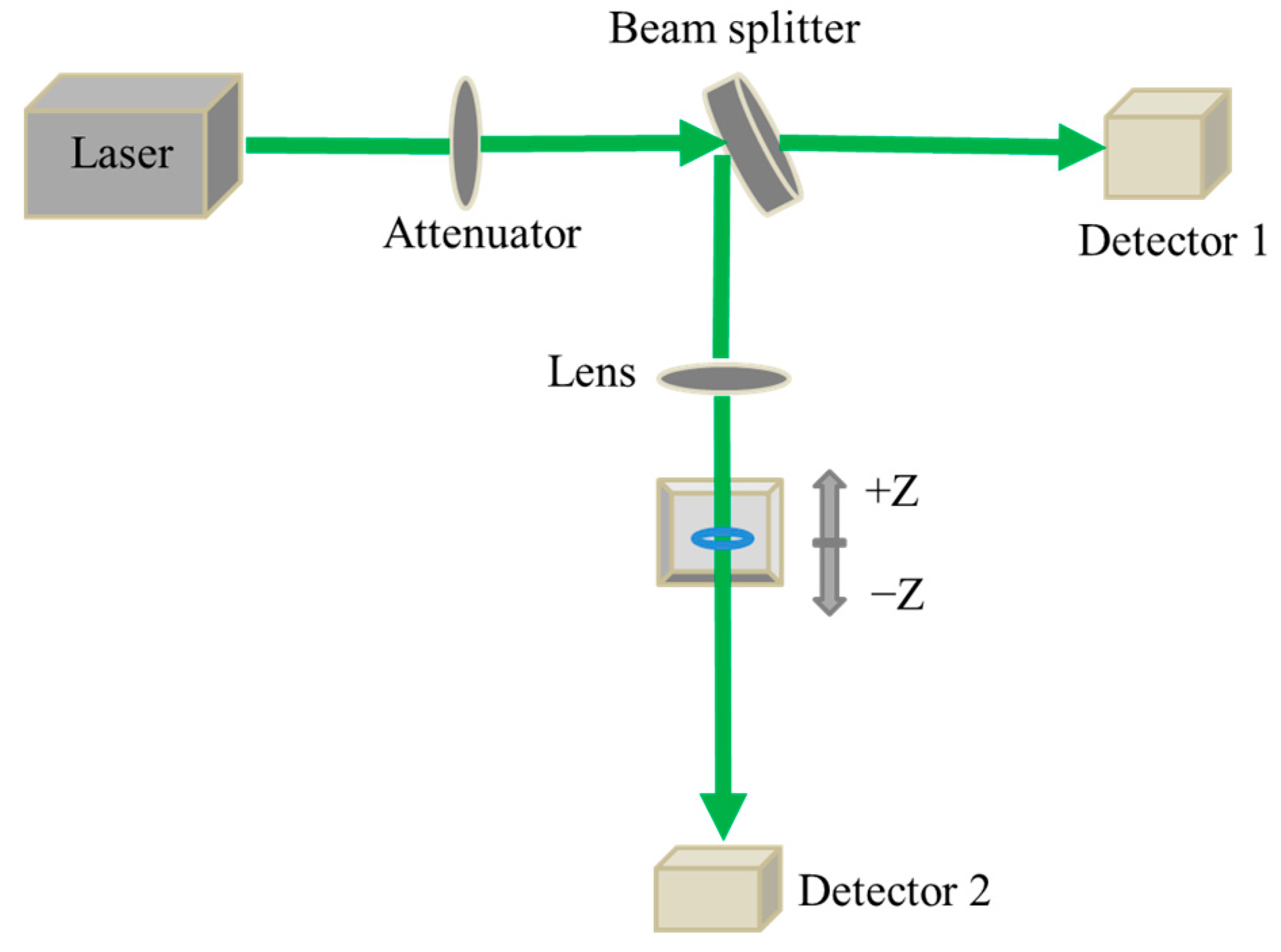
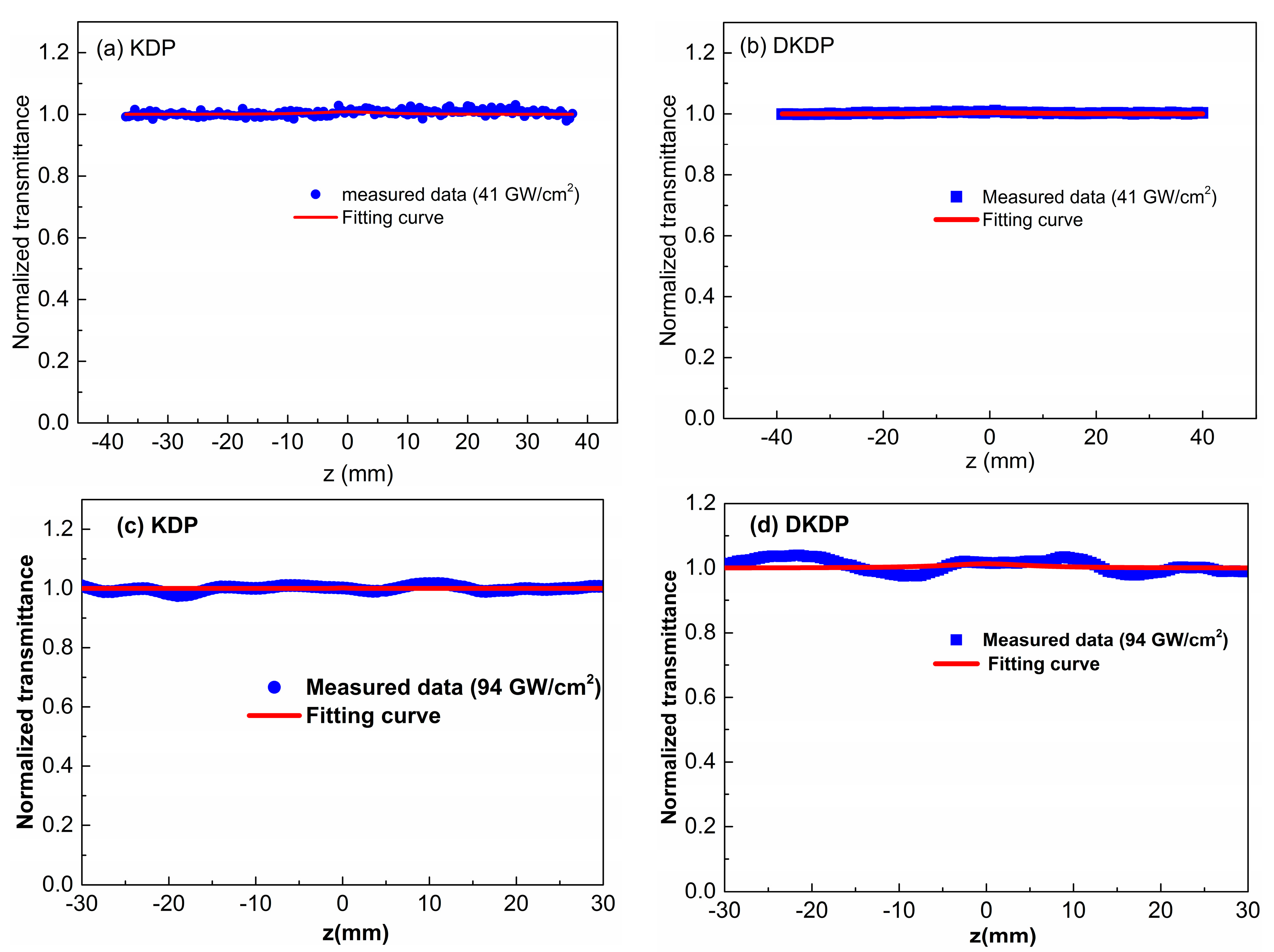
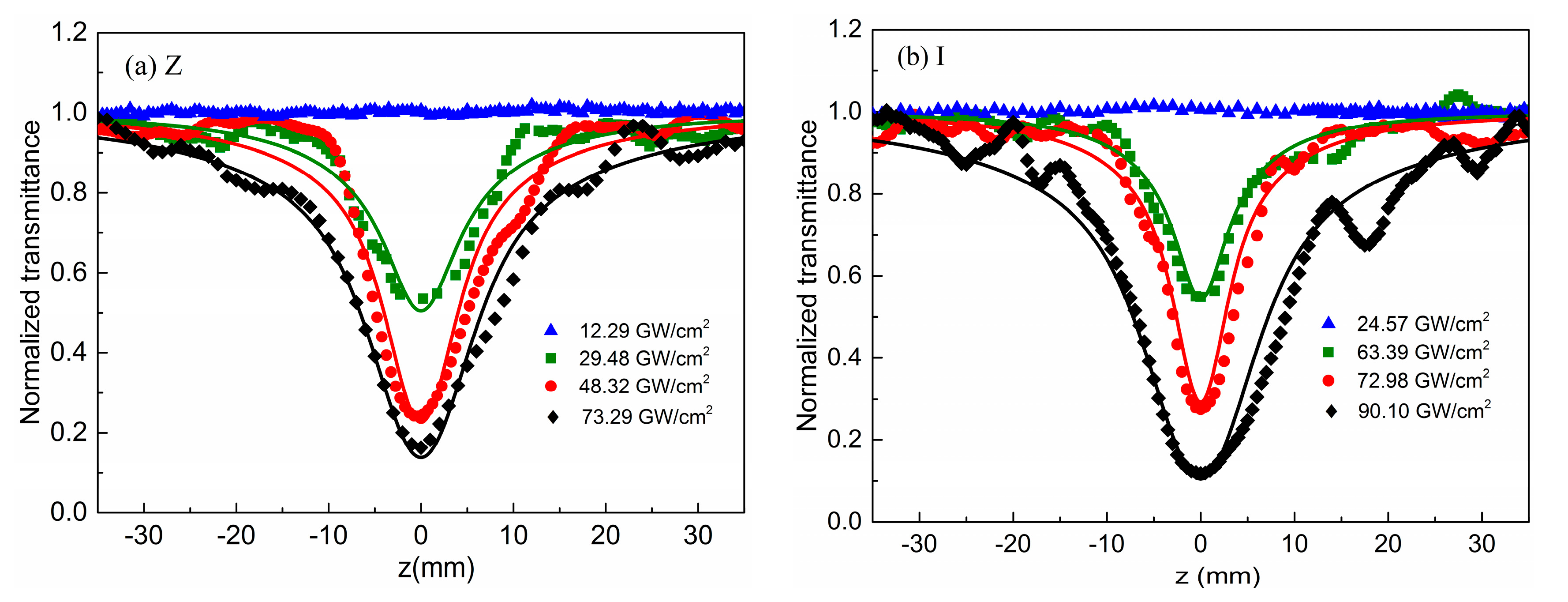
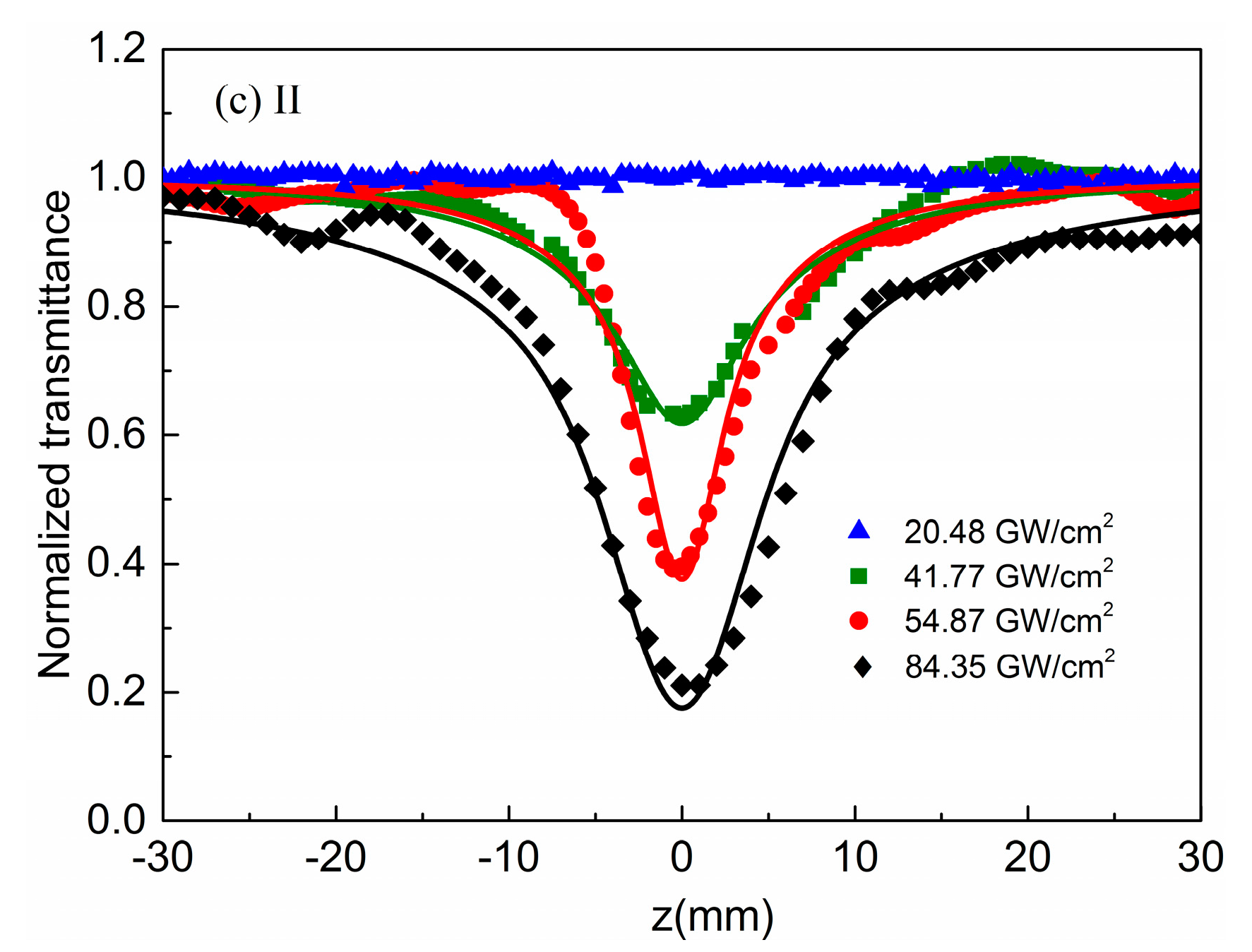
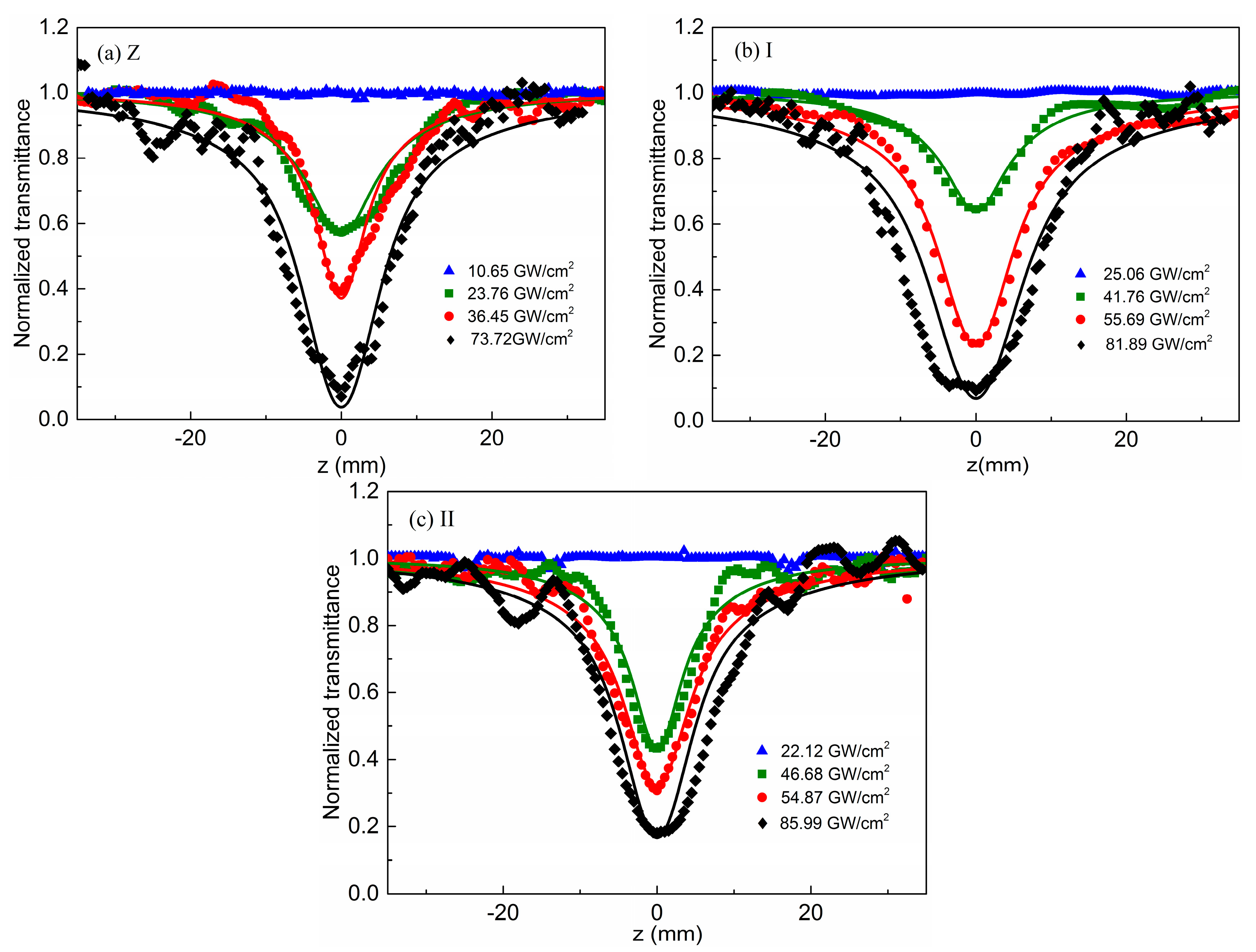
| Crystal and Laser Power Density (GW/cm2) | KDP | ||||||||
|---|---|---|---|---|---|---|---|---|---|
| Z | I | II | |||||||
| 29.48 | 48.32 | 73.29 | 63.39 | 72.98 | 90.10 | 41.77 | 54.87 | 84.35 | |
| β (10−10 cm/W) | 3.30 | 2.53 | 1.75 | 1.46 | 1.61 | 1.47 | 1.98 | 2.01 | 1.49 |
| (10−13 esu) | 4.95 | 3.79 | 2.63 | 2.19 | 2.41 | 2.20 | 2.97 | 3.01 | 2.24 |
| Crystal and Laser Power Density (GW/cm2) | 70%-DKDP | ||||||||
|---|---|---|---|---|---|---|---|---|---|
| Z | I | II | |||||||
| 23.76 | 36.45 | 73.72 | 41.76 | 55.69 | 81.89 | 46.68 | 54.87 | 85.99 | |
| β (10−10 cm/W) | 3.80 | 3.03 | 1.83 | 1.92 | 2.20 | 1.62 | 2.25 | 2.10 | 1.47 |
| (10−13 esu) | 5.69 | 4.55 | 2.74 | 2.87 | 3.29 | 2.43 | 3.37 | 3.14 | 2.20 |
© 2017 by the authors. Licensee MDPI, Basel, Switzerland. This article is an open access article distributed under the terms and conditions of the Creative Commons Attribution (CC BY) license (http://creativecommons.org/licenses/by/4.0/).
Share and Cite
Wang, D.; Wang, S.; Wang, J.; Shen, C.; Li, W.; Huang, P.; Liu, H.; Boughton, R.I. Research on Nonlinear Absorption Effect in KDP and 70%-DKDP Crystals. Crystals 2017, 7, 188. https://doi.org/10.3390/cryst7070188
Wang D, Wang S, Wang J, Shen C, Li W, Huang P, Liu H, Boughton RI. Research on Nonlinear Absorption Effect in KDP and 70%-DKDP Crystals. Crystals. 2017; 7(7):188. https://doi.org/10.3390/cryst7070188
Chicago/Turabian StyleWang, Duanliang, Shenglai Wang, Jiyang Wang, Chuanying Shen, Weidong Li, Pingping Huang, Hui Liu, and Robert I. Boughton. 2017. "Research on Nonlinear Absorption Effect in KDP and 70%-DKDP Crystals" Crystals 7, no. 7: 188. https://doi.org/10.3390/cryst7070188




